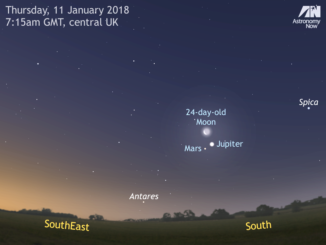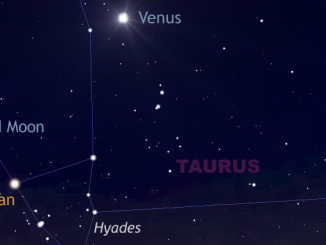
A partial eclipse of the Sun is set to wow North Americans this afternoon (23 October) as the Moon’s silhouette will be seen to cover as much as 50 percent of the Sun from the USA, and up to 80 percent of the Sun in northern Canada.
The further west you are, the more of the eclipse you will see, with the Sun having already set as seen from the East Coast and Florida before the eclipse reaches its maximum extent. From California the eclipse begins at 12:37pm PDT, when the Moon starts to take a nick out of the Sun, and ends at 5:51pm PDT. From Texas, the Sun will just be setting when the eclipse ends, while further east the Sun has set before the end of the eclipse. To find out where you fall under the eclipse line, see the accompanying chart or visit NASA’s eclipse website. Regardless, there will be no noticeable dip in sunlight during the eclipse as there is a total solar eclipse, although there will be a total eclipse for Americans to enjoy on 21 August 2017.

As always when viewing a solar eclipse, safety is paramount. Under normal circumstances, the Sun is a million times too bright to view directly with the unaided eye, so extreme care must be taken when observing the Sun. NEVER LOOK AT THE SUN WITH YOUR EYE, OR THROUGH BINOCULARS OR AN UNFILTERED TELESCOPE. If you do there is a very good chance that you will damage your eyesight, perhaps permanently blinding you. One need only think of the burning power of a magnifying glass to realise what concentrated, focused sunlight might do to an unprotected eye. There are safe ways to view the Sun, either through a specialist solar telescope or a normal telescope with specialist filters, through eclipse glasses with special mylar film, or the safest way, which is by projecting the image of the Sun onto card.
Projection
You don’t need a large telescope for this; a refractor with an aperture as small as 60mm is quite adequate. Apart from the telescope, all you need is an arrangement to support the projection screen – nothing more fancy than the blank cardboard inside of a cereal packet – and a snug light-blocking shield around the tube to cast a shadow, otherwise the Sun’s glare will wash out the projected image. Remember to keep the cap on any finderscope in case someone, such a child, accidentally looks through it, and absolutely do not look through the main eyepiece to aim at the Sun! Use the telescope’s own shadow to align the instrument. Avoid using a complex eyepiece as the heat may be sufficient to damage optical cements and coatings. Once the Sun’s disc appears on the projection screen, you can adjust the focus in the normal way. And while it may be low-tech, the big advantage of this system is that the projected image can be examined by a group of people simultaneously, making it great for public events.

Eclipse glasses
Special solar viewing shades using aluminised Mylar filters can be used for viewing partial solar eclipses. If you have a pair left over from viewing a previous eclipse, only use them if they are in good condition and their silvery filters are fully intact – check them for pinholes and if in any doubt throw them away and get some new Mylar filters. Never use these shades while attempting to view the Sun directly through binoculars or a telescope – the heat of the unfiltered Sun will quickly burn through the filters and cause permanent damage to the observer’s eyes. Additionally, the shades should never be taken apart and their filters used for makeshift whole aperture filters for very small telescopes such as finderscopes.
Solar filters
Whole aperture solar filters that cover the lens or corrector plate of the telescope allow the observer to view the Sun safely through the telescope eyepiece, enabling those with camera equipment to image using the prime focus, eyepiece projection or afocal methods. There are two main types of solar filter: aluminised Mylar filters and glass Inconel filters. Both types prevent most of the Sun’s light and heat from entering the telescope by reflecting it away, permitting only a safe level of solar energy to reach the eye.
Solar telescopes
Specialist solar telescopes, which have the filters built into them, offer safe viewing of the Sun across narrow wavelengths, the most popular being hydrogen-alpha light (the reddish light produced by excited hydrogen atoms). Dedicated solar telescopes are produced by companies such as Coronado and Lunt, and will not only show the eclipse but also great views of prominences, active regions and solar granulation.
However you choose to view the eclipse, stay safe and enjoy the view!




